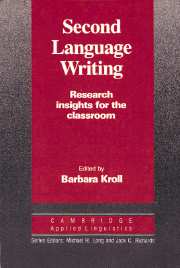II - CONSIDERATIONS FOR WRITING INSTRUCTION
Published online by Cambridge University Press: 05 October 2012
Summary
Several of the theoretical considerations that underlie second language writing instruction have been reviewed in Section I, providing an overview of the field. Section II features seven chapters describing a variety of empirically based studies. Each focuses on a different aspect of writing and/or the writing classroom, examining concepts and practices writing teachers need to know to best function in the classroom. These foci may be viewed as constraints on the writer or teacher that shape both composing behavior and course design. Each of the chapters reports on research findings that are directly connected to the insights about writing presented in Section I of the book, and each addresses still other key questions in the field. The options presented are just some of the many areas writers and writing teachers continue to explore as we learn more about this complex field.
Can using one's native language in composing assist the second language writer?
Chapter 7, by Alexander Friedlander, explores one constraint on the second language writer, namely, the language in which one chooses to carry out prewriting activities. Language can be seen as a constraint because lack of complete control over the linguistic code might limit a writer's possibility of exhibiting mastery over the discourse skills required to produce a particular type of text, a theory examined in a number of the studies summarized by Alexandra Rowe Krapels in her review of composing process research in Chapter 3.
- Type
- Chapter
- Information
- Second Language Writing (Cambridge Applied Linguistics)Research Insights for the Classroom, pp. 103 - 108Publisher: Cambridge University PressPrint publication year: 1990



